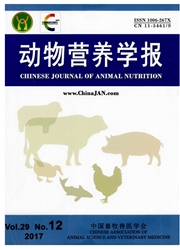

 中文摘要:
中文摘要:
氨基酸是胎儿生长发育、蛋白质生物合成和核酸代谢以及神经发育等的重要前体物质,氨基酸从母体到胎儿的转运及其代谢对生命活动具有极其重要的意义。谷氨酸(Glu)和谷氨酰胺(Gln)是胎盘组织中最丰富,也是妊娠后期猪胎儿中沉积最多的氨基酸;而Glu是由胎儿血浆净输出的唯一氨基酸,Gln转运到胎儿循环中速率最高。母体、胎盘和胎儿之间Glu-Gln循环、交换和代谢对胎儿生长发育具有关键的作用,可能是母体与胎儿发育之间的主要介导途径。本文综述了胎盘胎儿复合体Glu-Gln代谢规律、生理功能及其可能的调控机制,探讨了N-氨甲酰谷氨酸对胎盘胎儿复合体中Glu-Gln循环的影响及其调控机制,为Glu-Gln在胎盘胎儿复合体的代谢及其调控的研究提供参考。
 英文摘要:
英文摘要:
Amino acids are important precursor substances for the development and growth of fetus, the biosynthesis of proteins, metabolism of nucleotides, and neurodevelopment. The transfer from mother to fetus and its metabolites of amino acids are extremely important for life activities. Glutamate and glutamine are the most abundant in placenta, and the maximum deposition of amino acids in fetus of pigs during late pregnancy. Glutamate is the only amino acid net output from the fetal plasma, and glutamine transported to the fetal circulation with the highest rate. Glutamate-glutamine cycle, exchange and metabolism between mother, placenta and fetus play a key role on fetal growth and development. This may be the main mediated pathway between maternal and fetal development. This paper reviews glutamate-glutamine metabolic, physiological functions and possible regulating mechanism in placenta-fetus unit, and the effect of N-carbamoylglutamate on glutamate-glutamine cycle in placenta-fetus unit and the regulating mechanism, to provide a reference for the study of metabolism and its regulation of glutamate-glutamine in placenta-fetus unit.
 同期刊论文项目
同期刊论文项目
 同项目期刊论文
同项目期刊论文
 Preventive oral supplementation with glutamine and arginine has beneficial effects on the intestinal
Preventive oral supplementation with glutamine and arginine has beneficial effects on the intestinal Effects of dietary L-arginine or N-carbamylglutamate supplementation during late gestation of sows o
Effects of dietary L-arginine or N-carbamylglutamate supplementation during late gestation of sows o The acute and chronic effects of monosodium L-glutamate on serum iron and total iron-binding capacit
The acute and chronic effects of monosodium L-glutamate on serum iron and total iron-binding capacit Effect of dietary arginine and N-carbamoylglutamate supplementation on reproduction and gene express
Effect of dietary arginine and N-carbamoylglutamate supplementation on reproduction and gene express The results of some studies involving animal models of obesity induced by monosodium glutamate are n
The results of some studies involving animal models of obesity induced by monosodium glutamate are n 期刊信息
期刊信息
